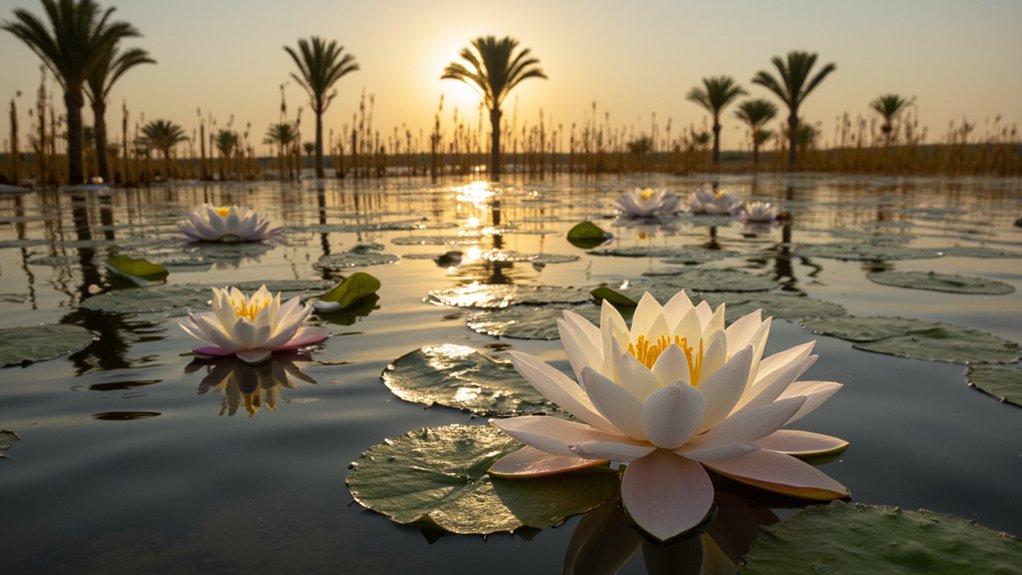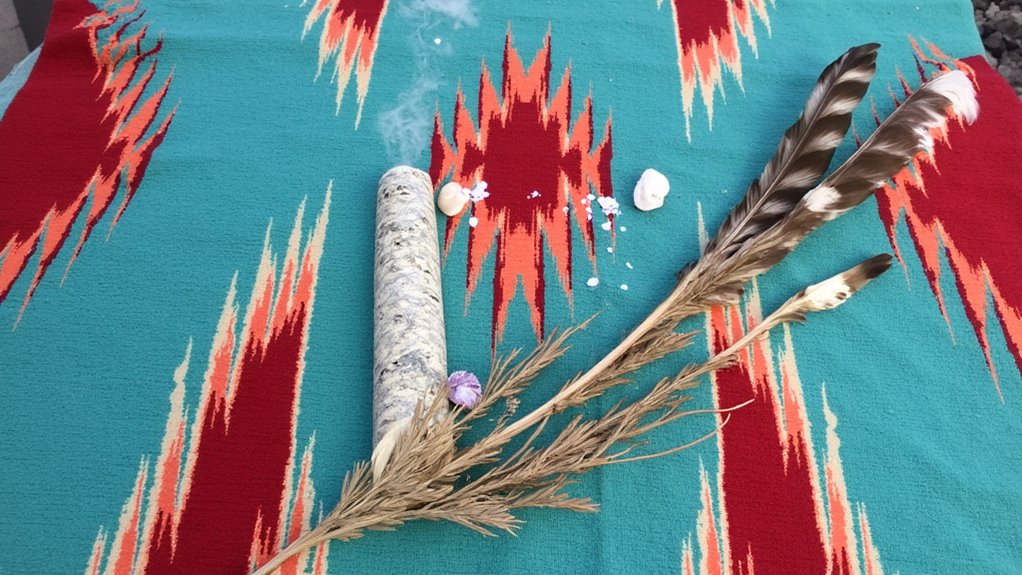Like the ancient Greeks who found divine messages in laurel leaves, you’ll discover that sacred plants have shaped human spirituality for millennia. You’ve likely encountered some of these botanical bridges between heaven and earth – perhaps burning sage for cleansing or placing an olive branch as a peace offering. As you explore the world’s sacred flora, you’ll uncover how these plants continue to influence modern practices, from traditional medicine to contemporary wellness rituals.
Contents
Ancient Egyptian Sacred Flora: From Lotus to Papyrus

Countless sacred plants held profound significance in ancient Egyptian culture, with the lotus and papyrus reigning supreme among them. You’ll find the blue lotus flower depicted in countless tombs and temples, where it symbolized Ra’s daily rebirth and creation itself.
The papyrus plant wasn’t just for making scrolls – it represented Lower Egypt and played a key role in mythology. When you examine temple columns, you’ll notice they’re often designed to look like bundled papyrus stalks, reaching heights of 30-40 feet.
These plants weren’t mere decorations; they’re woven into hieroglyphs, medicine, and religious ceremonies that lasted for over 3,000 years.
Sacred Plants in Native American Traditions

While ancient Egyptians revered the lotus and papyrus, Native American tribes across North and South America developed deep spiritual connections with an entirely different set of plants.
You’ll find sage, sweetgrass, tobacco, and cedar at the heart of many Native American ceremonies. These “sacred four” medicines have been used for thousands of years in smudging rituals, where they’re burned to purify spaces and people.
If you’re studying traditional practices, you’ll notice that tribes in the Southwest particularly valued peyote for ceremonial use, while Pacific Northwest nations incorporated cedar into everything from ceremonial masks to purification rituals.
Asian Spiritual Botanicals: From India to Japan

Throughout Asia’s vast spiritual traditions, you’ll discover a rich tapestry of sacred plants that have shaped religious practices for over 5,000 years. From the lotus flowers adorning Buddhist temples to the sacred tulsi basil in Hindu households, these botanicals serve both spiritual and medicinal purposes.
In Japan, you’ll find the sakaki tree, central to Shinto purification rituals, while China’s ginseng root has been revered for its life-extending properties since 2,700 BCE. Indian temples cultivate sacred groves of neem and peepal trees, where you can’t harvest leaves without specific prayers and ceremonies.
The bamboo plant spans multiple Asian cultures, symbolizing resilience and enlightenment through its hollow core and upward growth.
Mediterranean & Middle Eastern Holy Plants
In the sacred landscapes of Mediterranean and Middle Eastern traditions, you’ll find olive trees and frankincense taking center stage as botanical pillars of faith. While olive branches symbolize peace in Abrahamic faiths, frankincense’s aromatic resin has been burned in religious ceremonies for over 5,000 years.
You’ll encounter cedar trees in Lebanon, which King Solomon used to build his temple, and the date palm, mentioned over 20 times in the Quran. Myrrh, another significant resin, appears in ancient Egyptian embalming recipes and was among the gifts presented to baby Jesus.
These plants don’t just carry spiritual significance – they’ve shaped trade routes and economies throughout history.
Sacred Plant Ceremonies of Indigenous Americas
Sacred ceremonies of Native American tribes frequently center around powerful plant medicines like peyote, tobacco, and ayahuasca that you’ll find woven into their spiritual practices. These ceremonies often take place in dedicated spaces like sweat lodges or medicine circles, where you’ll see elders burning sage or cedar for purification.
During traditional rituals, you’ll observe specific protocols: tobacco’s offered as a gift to spirits, while peyote ceremonies can last 12 hours or more. In the Amazon, shamanic traditions incorporate ayahuasca brews prepared from Banisteriopsis caapi vines mixed with Psychotria viridis leaves, which they’ll serve in nighttime ceremonies guided by experienced healers.
Modern Uses of Traditional Sacred Plants
Traditional plant medicines have found their way into contemporary wellness practices, though often in forms quite different from their indigenous roots. You’ll find ayahuasca retreats in luxury centers, while peyote-derived mescaline is being studied for therapeutic applications. Even your local health store likely carries sage smudge sticks and ceremonial sweetgrass.
Scientific research has validated many traditional uses, with compounds like salvinorin A from Salvia divinorum showing promise in neuroscience. You’re now able to access these plants’ benefits through standardized extracts, microdoses, and clinical trials – though it’s essential to respect their cultural origins and proper safety protocols.
